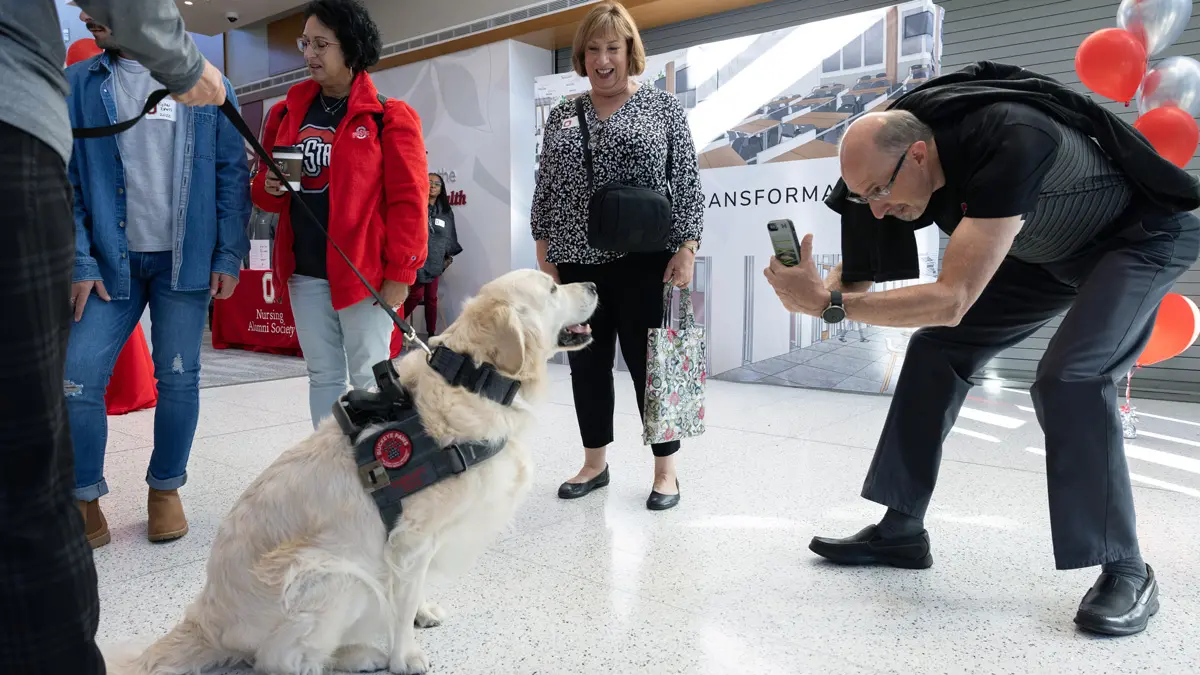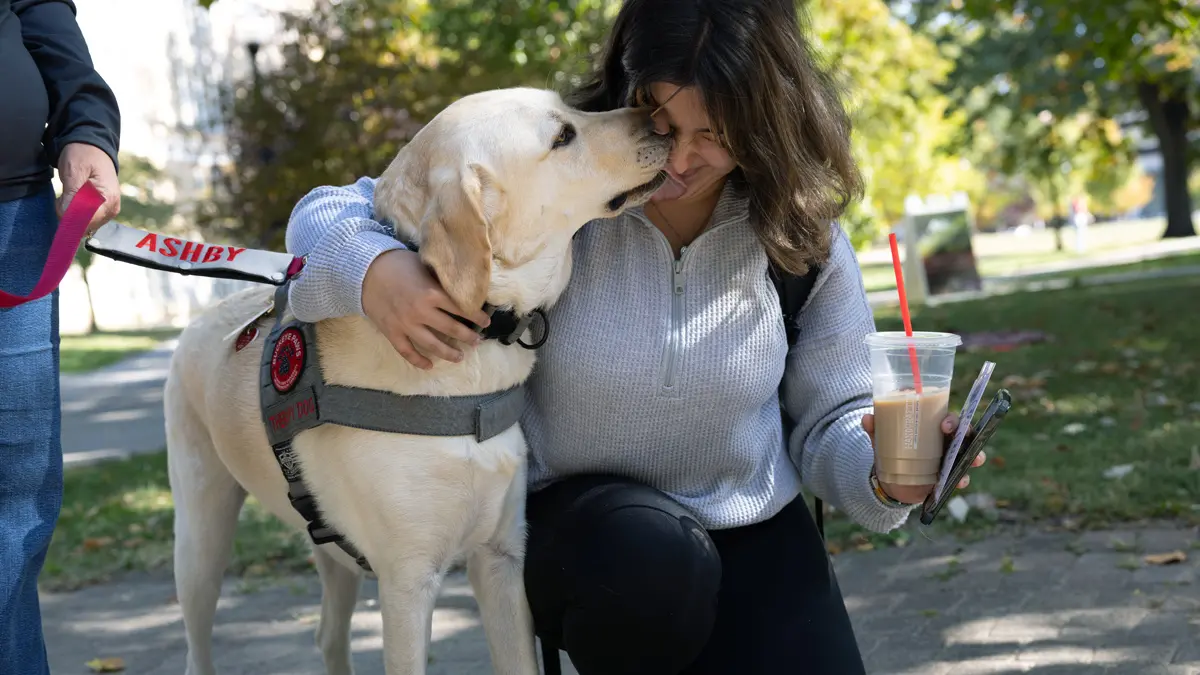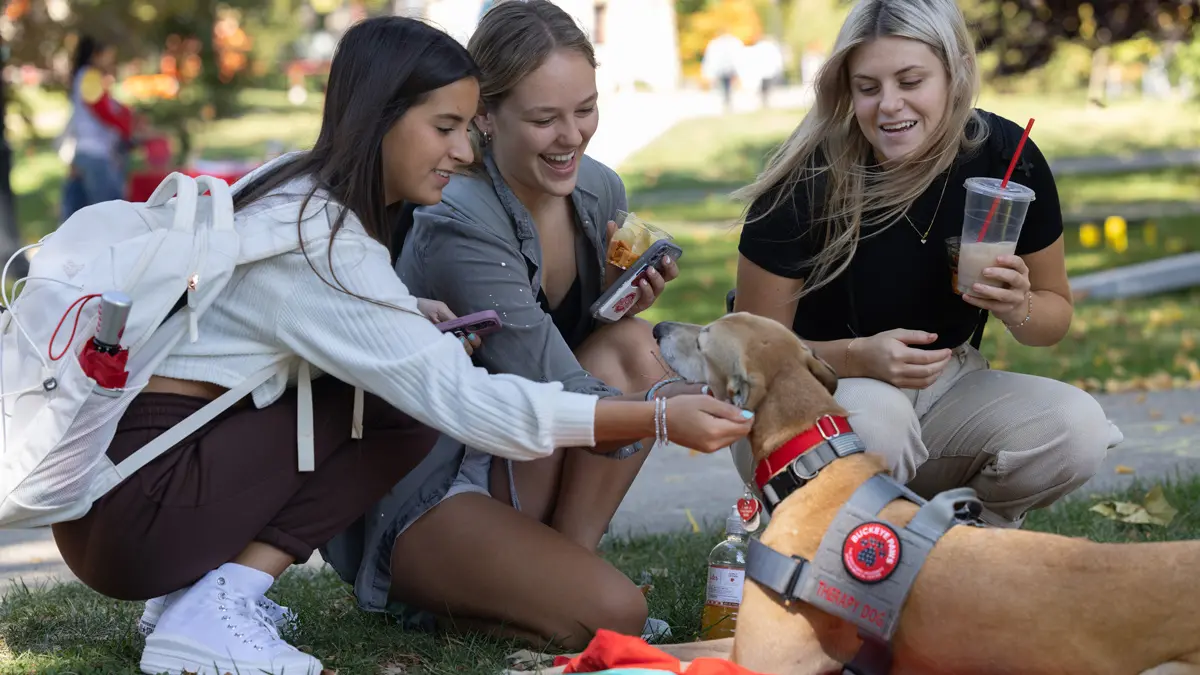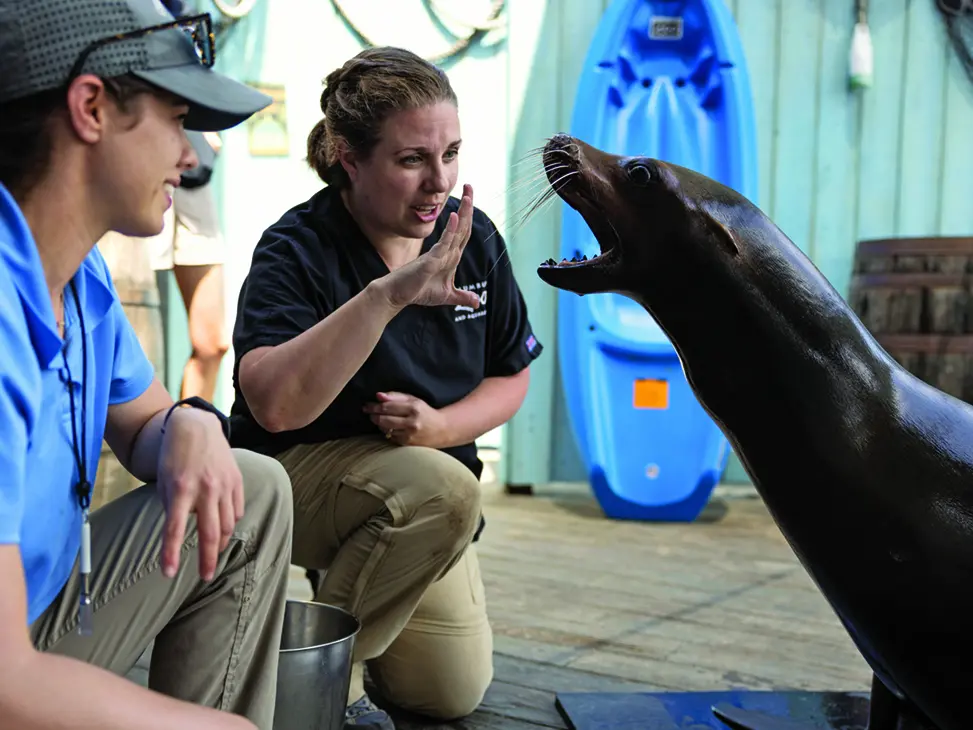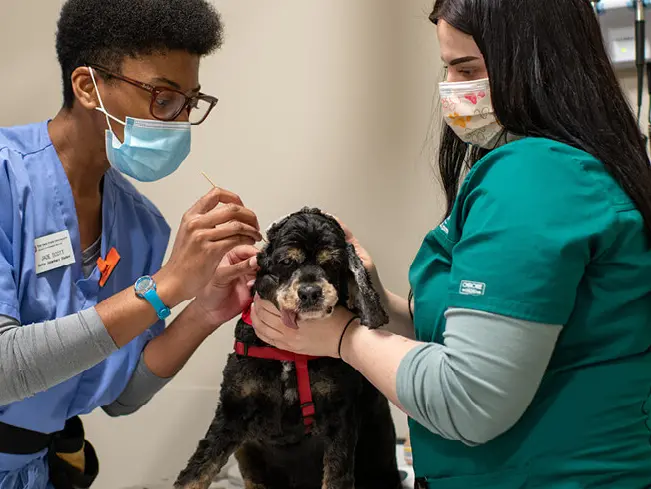These dogs give love, no strings attached
Buckeye Paws therapy pups have snuggled their way into workspaces across Ohio State, offering comfort, unconditional affection and a boost to our community’s well-being.

“As a kid who has grown up with dogs my entire life, I know the magic they can provide,” says second-year student Pierce Ormond, a cheerleading team and spirit squad member who caught up with Mya from Buckeye Paws at a football tailgate this fall. “Dogs just enlighten any environment — simple as that.”
No matter their time in the field, nurses never get used to losing their patients. So when Nurse Manager Lauren Bergstrom and her team experienced the death of three patients in five days within their 16-bed Neurosciences Critical Care Unit, the toll was especially heavy.
The nurses approached Bergstrom with an important request: Please arrange a visit from Buckeye Paws.
The Ohio State therapy dog program launched nearly three years ago to support the mental and emotional well-being of health care professionals with Wexner Medical Center. It has since expanded across the Columbus campus and begun to branch out to regional campuses.
“They needed a morale boost,” Bergstrom says of her colleagues, who care for patients recovering from stroke, trauma or neurological surgery. “They actually asked me to get the dogs for them.”
Buckeye Paws program manager and graduate student Aimee Mitchell quickly arranged for a team of certified therapy dogs and trained handlers to visit and stay as long as the nurses needed to hold or pet the animals. Some did so in silence, others in tears.
“There is a healing component in this kind of interaction,” says Mary Justice ’92, who co-founded Buckeye Paws with Beth Steinberg ’84, ’99 MS, ’22 PhD. “The dogs offer nonjudgmental support for all.”
Supporting their med center colleagues was the major motivator for Steinberg and Justice, who have worked in nursing. Together, the two trained their dogs for this mission and worked through hospital and university approvals before introducing Buckeye Paws in March 2020. Many hospitals have therapy pet programs dedicated to patient mental health and wellbeing; Buckeye Paws is one of only a handful in the United States aimed at supporting caregivers.
The program had just started when the COVID-19 pandemic began affecting Central Ohio. As it became apparent that medical providers worldwide were becoming physically and emotionally overwhelmed, Justice and Steinberg saw their timing as a blessing.
“We would walk onto a unit with the dogs, and we could see the stress drain out of caregivers’ faces,” Steinberg says. “When they gathered around the dogs, there was a sense of connection among the staff, and they began communicating more.”
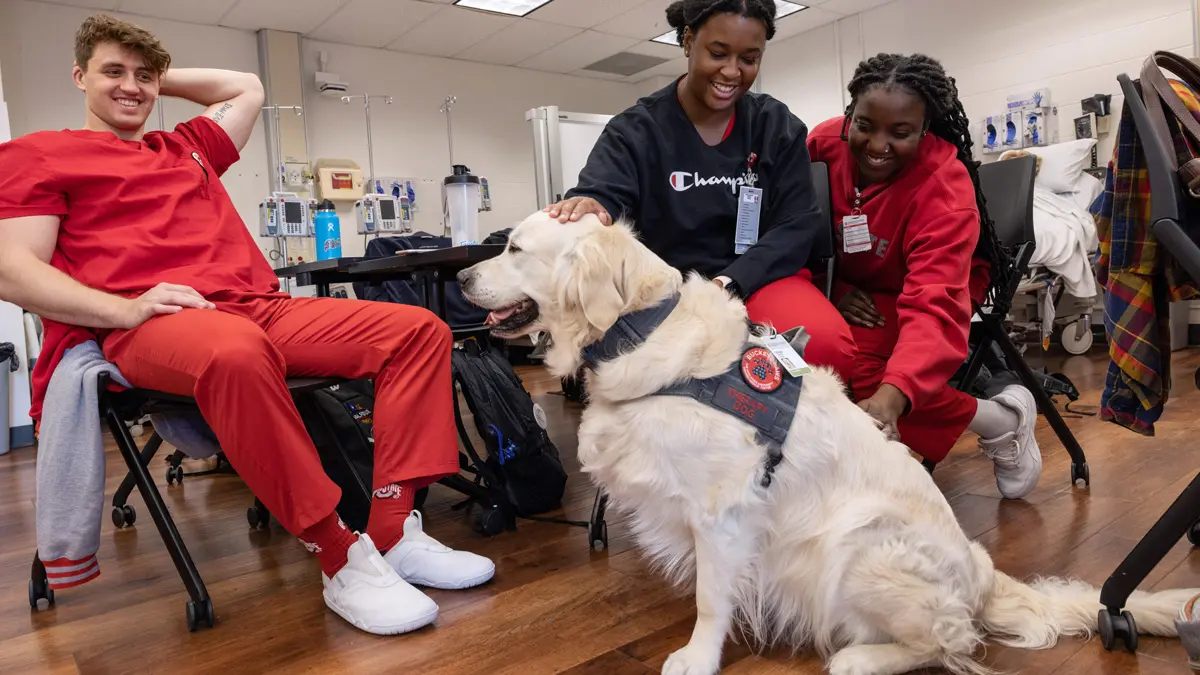
Humans have increased activity in the brain’s prefrontal cortex while interacting with dogs, helping them regulate and process social and emotional encounters. Getting a dose of Shiloh here are nursing students (from left) Tanner Smith, Roslyn Perry and Chinazam Uhegwu.
Adds Justice: “They were having conversations with themselves and the dogs about how their day had been going. It’s truly therapeutic for individuals as well as teams.”
About 18 months after the program’s launch, Steinberg, research project coordinator for the Center for Integrative Health, began to study its impact on care providers working in high-intensity units. Over an eight-week period, Ohio State nurses, doctors and other caregivers in two intensive care units and two surgical units interacted with the dogs at least once a week. The result was a significant improvement in participants’ self-reported mood across all four units.
“We have been able to show Buckeye Paws has a positive impact on health care workers and may well counteract the negative effects of work-related stress,” says Steinberg, who soon will turn her research focus to the dogs’ well-being in a partnership with College of Veterinary Medicine researchers.
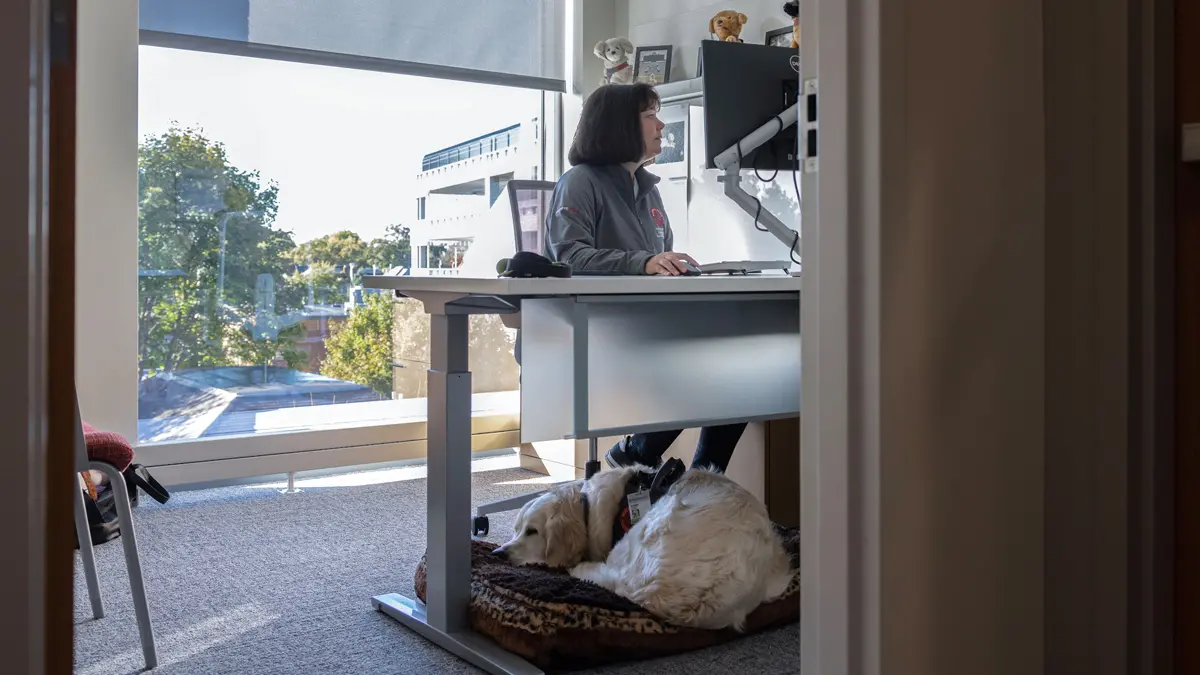
On most weekdays, Shiloh heads to the College of Nursing, where Justice is the senior fiscal officer and director of entrepreneurial initiatives. That way, the pair can quickly respond to requests for support or make visits around Wexner Medical Center or campus.
Buckeye Paws expanded to the rest of the Columbus campus this past spring. In all, handlers and dogs have responded to more than 1,500 requests for visits, most coming from medical staff. That’s not counting many unstructured — but always welcomed — appearances by the dogs. Requests are on the rise as the program gains more visibility.
Buckeye Paws has 32 dogs and 36 handlers, all Ohio State employees who volunteer their time on top of their regular duties. Handlers are trained in trauma-informed care and psychological first aid to respond effectively and connect those they encounter with mental health care if needed.

Cascade, a greyhound belonging to graduate student Carrie Anne Thomas, lounges at home with her buddies. Steinberg and College of Veterinary Medicine researchers are looking into how serving as therapy dogs affects the animals.
In founding Buckeye Paws, Justice (and her golden retriever Shiloh) and Steinberg (and her yellow lab Brienne) hoped to bring more joy to the workplace. Looking into the faces of those who interact with the dogs, there is no doubt they’ve accomplished their goal.
“Even with their masks on,” Steinberg says, “you can see their eyes smile.”
Not ready to move on?
More about Buckeye Paws’ adorable helpers can be found on the group’s website, where you can meet the team, further learn about the program and view photo galleries.


